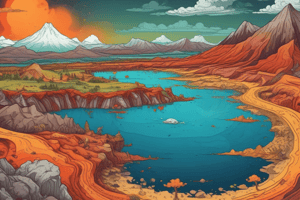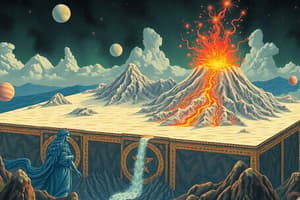Podcast
Questions and Answers
Which of the following geological formations results from magma solidifying underground in horizontal sheets between rock layers?
Which of the following geological formations results from magma solidifying underground in horizontal sheets between rock layers?
- Parasitic Cone
- Dike
- Sill (correct)
- Batholith
A 'vent' is a large underground reservoir of magma.
A 'vent' is a large underground reservoir of magma.
False (B)
Briefly describe the difference between magma and lava.
Briefly describe the difference between magma and lava.
Magma is molten rock beneath the Earth's surface, while lava is magma that has erupted onto the surface.
A circular depression at the top of a volcano is called a ______.
A circular depression at the top of a volcano is called a ______.
Match the following volcanic features with their descriptions:
Match the following volcanic features with their descriptions:
Which process describes magma breaking through the Earth’s crust and erupting?
Which process describes magma breaking through the Earth’s crust and erupting?
Volcanoes are only found on land.
Volcanoes are only found on land.
What is the role of a volcanologist?
What is the role of a volcanologist?
Which geological process is most directly associated with the formation of volcanoes at convergent plate boundaries?
Which geological process is most directly associated with the formation of volcanoes at convergent plate boundaries?
Divergent boundaries always result in explosive volcanic eruptions due to the high gas content of the magma involved.
Divergent boundaries always result in explosive volcanic eruptions due to the high gas content of the magma involved.
Name three indicators that a volcano may be about to erupt.
Name three indicators that a volcano may be about to erupt.
A volcano that is not currently erupting but has the potential to erupt in the future is classified as ______.
A volcano that is not currently erupting but has the potential to erupt in the future is classified as ______.
Match the following types of volcanic eruptions with their descriptions:
Match the following types of volcanic eruptions with their descriptions:
Which factor primarily determines the explosiveness of a volcanic eruption?
Which factor primarily determines the explosiveness of a volcanic eruption?
Volcanic bombs are small, liquid droplets of lava ejected during a volcanic eruption.
Volcanic bombs are small, liquid droplets of lava ejected during a volcanic eruption.
Explain how the silica content in magma affects the viscosity and explosiveness of a volcanic eruption.
Explain how the silica content in magma affects the viscosity and explosiveness of a volcanic eruption.
Which type of magma is most likely to produce a violent eruption?
Which type of magma is most likely to produce a violent eruption?
Shield volcanoes are primarily formed by explosive eruptions of andesitic lava.
Shield volcanoes are primarily formed by explosive eruptions of andesitic lava.
Name two materials from volcanic eruptions, that can significantly affect Earth's climate or environment.
Name two materials from volcanic eruptions, that can significantly affect Earth's climate or environment.
A volcanic mudflow, also known as a ______, can bury villages.
A volcanic mudflow, also known as a ______, can bury villages.
Match the following volcano types with their typical eruption style:
Match the following volcano types with their typical eruption style:
Which of the theories explains that eruptions occur due to plate movement?
Which of the theories explains that eruptions occur due to plate movement?
An increase in seismic activity is not considered a warning sign of an impending volcanic eruption.
An increase in seismic activity is not considered a warning sign of an impending volcanic eruption.
What is the correct order of the process of a volcanic eruption?
What is the correct order of the process of a volcanic eruption?
Which characteristic of magma is the primary determinant of its explosiveness during a volcanic eruption?
Which characteristic of magma is the primary determinant of its explosiveness during a volcanic eruption?
Geothermal heat pumps can only be effectively used in areas with high volcanic activity.
Geothermal heat pumps can only be effectively used in areas with high volcanic activity.
In geothermal power plants, what is the role of a turbine?
In geothermal power plants, what is the role of a turbine?
__________ magma, characterized by its low silica content and high temperature, is associated with non-explosive eruptions and shield volcanoes.
__________ magma, characterized by its low silica content and high temperature, is associated with non-explosive eruptions and shield volcanoes.
Match the type of magma with its corresponding eruption style:
Match the type of magma with its corresponding eruption style:
At what stage in a geothermal power plant cycle does water turn into steam?
At what stage in a geothermal power plant cycle does water turn into steam?
Rhyolitic magma generally has a lower temperature compared to basaltic and andesitic magma.
Rhyolitic magma generally has a lower temperature compared to basaltic and andesitic magma.
Which of the following magma types is most likely to form composite volcanoes such as Mount St. Helens?
Which of the following magma types is most likely to form composite volcanoes such as Mount St. Helens?
Flashcards
Basaltic Magma
Basaltic Magma
Low silica, very fluid magma causing mild eruptions.
Andesitic Magma
Andesitic Magma
Medium silica magma leading to moderate explosions.
Granitic (Rhyolitic) Magma
Granitic (Rhyolitic) Magma
High silica, thick magma that causes violent eruptions.
Shield Volcanoes
Shield Volcanoes
Signup and view all the flashcards
Composite Volcanoes
Composite Volcanoes
Signup and view all the flashcards
Cinder Cone Volcanoes
Cinder Cone Volcanoes
Signup and view all the flashcards
Tectonic Theory
Tectonic Theory
Signup and view all the flashcards
Warning Sign of Eruption
Warning Sign of Eruption
Signup and view all the flashcards
Volcano
Volcano
Signup and view all the flashcards
Volcanologists
Volcanologists
Signup and view all the flashcards
Magma
Magma
Signup and view all the flashcards
Lava
Lava
Signup and view all the flashcards
Crater
Crater
Signup and view all the flashcards
Vent
Vent
Signup and view all the flashcards
Lava Flow
Lava Flow
Signup and view all the flashcards
Convergent Boundaries
Convergent Boundaries
Signup and view all the flashcards
Ash Cloud
Ash Cloud
Signup and view all the flashcards
Divergent Boundaries
Divergent Boundaries
Signup and view all the flashcards
Active Volcano
Active Volcano
Signup and view all the flashcards
Dormant Volcano
Dormant Volcano
Signup and view all the flashcards
Extinct Volcano
Extinct Volcano
Signup and view all the flashcards
Explosive Eruption
Explosive Eruption
Signup and view all the flashcards
Types of Eruptions
Types of Eruptions
Signup and view all the flashcards
Volcanic Bombs
Volcanic Bombs
Signup and view all the flashcards
Rhyolitic Magma
Rhyolitic Magma
Signup and view all the flashcards
Geothermal Heat Pump
Geothermal Heat Pump
Signup and view all the flashcards
Geothermal Energy
Geothermal Energy
Signup and view all the flashcards
Volcanic Eruption Styles
Volcanic Eruption Styles
Signup and view all the flashcards
Power Plant Steps
Power Plant Steps
Signup and view all the flashcards
Study Notes
Volcanoes
- Volcanoes are openings in Earth's crust where magma, gases, and ash escape to the surface.
- Eruptions form new land as magma cools to lava.
- Volcanoes are often found along tectonic plate boundaries.
How Volcanoes Form
Intrusion (Formation Beneath the Surface)
- Magma pushes into existing rock layers, cooling and solidifying underground.
- This creates features such as sills (horizontal), dikes (vertical), batholiths, and laccoliths (large underground magma reservoirs).
Extrusion (Eruption Onto the Surface)
- Magma breaks through the Earth's crust.
- Erupts as lava, ash, or gases.
- Lava cools and builds layers, forming volcanic mountains or islands.
Plate Boundaries and Volcanoes
Convergent Boundaries (Destructive)
- Two plates collide, one subducting (sliding under the other).
- Subducted plate melts into magma, rising to form volcanoes.
- Example: The Ring of Fire.
Divergent Boundaries (Constructive)
- Two plates move apart, allowing magma to rise.
- Forms underwater volcanoes that can become islands.
- Example: Mid-Atlantic Ridge, Iceland.
Monitoring Volcanoes
- Volcanologists study volcanoes to predict eruptions and mitigate risks.
Parts of a Volcano
- Magma: Molten rock beneath the surface.
- Lava: Magma that has erupted onto the surface.
- Crater: Circular depression at the top of the volcano.
- Vent: Opening where magma and gases escape.
- Main vent: Primary passageway for magma.
- Summit: Peak of the volcano.
- Flank: Side of the volcano.
- Parasitic cone: Smaller cones on the main volcano.
- Conduit: Underground passage carrying magma.
- Sill: Horizontal intrusion of magma.
- Ash fragments: Tiny rock particles ejected in eruptions.
- Ash cloud: Cloud of ash and gas from explosive eruptions.
- Magma chamber: Large underground reservoir of magma.
- Lava flow: Movement of erupted lava.
- Secondary vent: Additional openings for magma.
- Layers of rock: Repeated lava eruptions.
- Volcanic bombs: Large, solid chunks of ejected lava
Types of Volcanoes (Based on Activity)
- Active: Currently erupting or likely to erupt.
- Dormant: Not currently erupting but may in the future.
- Extinct: No longer capable of erupting.
What Determines Explosiveness?
- Gas content: More trapped gas = more explosive.
- Magma viscosity: Thick magma traps gas = more explosive.
- Silica content: High silica = high viscosity.
- Water vapor: More water = bigger eruptions.
Types of Volcanic Eruptions
- Phreatic: Steam-driven, no lava.
- Phreatomagmatic: Magma and water interact, violent.
- Strombolian: Short bursts of lava.
- Vulcanian: Moderate explosions with thick ash clouds.
- Plinian: Extremely powerful, towering ash clouds.
- Pyroclastic flow: Mixture of gases, water, and ash.
Magma Composition
- Basaltic: Low silica, very fluid, mild eruptions (e.g., Hawaiian).
- Andesitic: Medium silica, moderate explosions (e.g., Mount St. Helens).
- Rhyolitic (Granitic): High silica, thick magma, causes violent, explosive eruptions (e.g., Yellowstone).
Types of Volcanoes (Based on Shape)
- Shield volcanoes: Wide, gently sloping, non-explosive, steady lava flows. (e.g., Mauna Loa, Kilauea)
- Composite volcanoes (stratovolcanoes): Steep-sided, tall, explosive, alternating lava and ash layers. (e.g., Mount St. Helens)
- Cinder cone volcanoes: Small, steep-sided, short-lived, explosive, basaltic lava. (e.g., Paricutin)
Geothermal Energy
- Geothermal energy uses heat from the Earth's interior.
- Geothermal power plants use steam from deep underground to turn turbines, generating electricity.
Studying That Suits You
Use AI to generate personalized quizzes and flashcards to suit your learning preferences.




